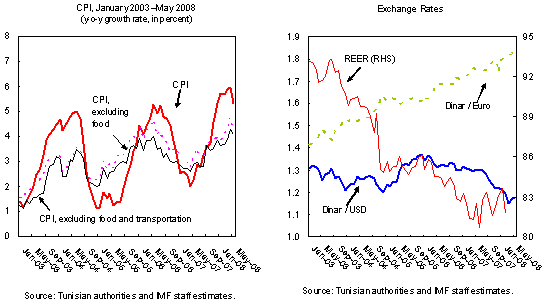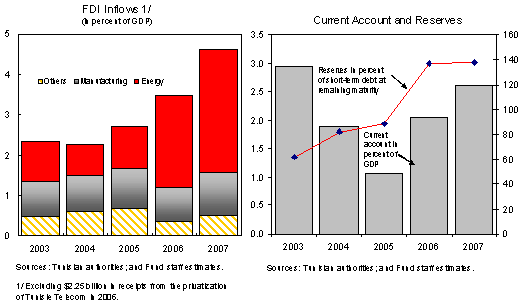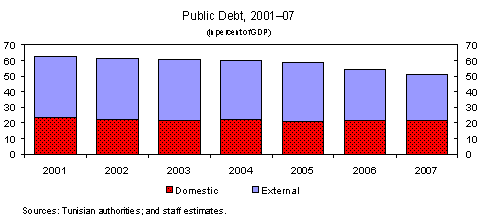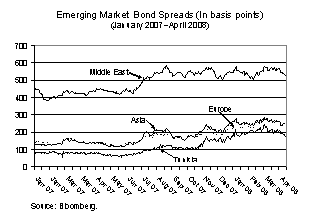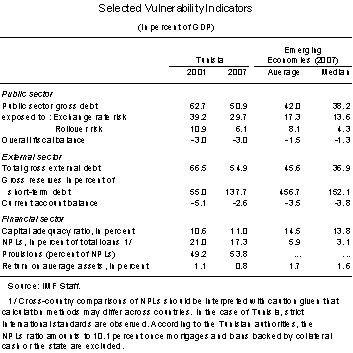Tunisia -- Concluding Statement of the Article IV Consultation Mission
July 10, 2008
Describes the preliminary findings of IMF staff at the conclusion of certain missions (official staff visits, in most cases to member countries). Missions are undertaken as part of regular (usually annual) consultations under Article IV of the IMF's Articles of Agreement, in the context of a request to use IMF resources (borrow from the IMF), as part of discussions of staff monitored programs, and as part of other staff reviews of economic developments.
I. Introduction
1. The mission that visited Tunis May 27-June 9, 2008 wishes to thank the authorities for their excellent cooperation, the high quality of the discussions, their usual warm hospitality, and their full availability.
2. Good economic management and social policies continue to bear fruit, as evidenced by accelerated growth and improved social indicators. Real GDP growth over the last ten years averaged 5 percent and real GDP per capita increased by 45 percent between 1997 and 2007.
3. In the short term, the major challenge is to limit the impact on inflation and growth resulting from rising world prices of food and petroleum products and global financial turbulence. The slowdown in growth in the European Union (EU), partly due to current financial upheavals, could adversely affect Tunisia.
4. Tunisia's medium-term objective is to further reduce the unemployment rate, particularly during a period in which the country is undergoing a profound demographic shift. Unemployment has declined in recent years, yet it remains relatively high-14.1 percent in 2007—especially as Tunisia is recording a considerable increase in university graduates.
5. To achieve these objectives, Tunisia must continue to strengthen its resiliency to external shocks by strengthening its macroeconomic position and by pursuing structural reforms, including in the financial sector.
II. Recent Economic and Financial Developments
6. Until now, Tunisia has withstood external shocks relatively well:
• Growth in real GDP has accelerated from 5.5 percent in 2006 to 6.3 percent in 2007, reflecting the favorable performance of agriculture, energy, manufacturing industries, and the services sector. On the demand side, this performance reflects the dynamic behavior of exports and investment. Economic growth slowed in first quarter 2008 but held relatively firm at 5.8 percent, above the average level achieved during the past decade. The slowdown is primarily attributable, in part, to the decline in production of hydrocarbons on account of temporary technical difficulties and also to the economic slowdown in Europe.
• After falling to 3.1 percent in 2007 from 4.5 percent in 2006, inflation has picked up once again, largely as a result of renewed increases in world prices of food and petroleum products. In fact, year-on-year inflation reached 5.3 percent in May 2008. Inflation is also accounted for by pressures on domestic demand deriving in particular from foreign direct investment (FDI). The nominal effective exchange rate depreciated by 2.8 percent in 2007, on the basis of the index calculated by the IMF, thereby contributing to the inflation acceleration.
• The Central Bank of Tunisia (BCT) responded to inflationary pressures by tightening monetary policy from the second half of 2007. The BCT thus mopped up liquidity through deposit auctions and open-market operations. In addition, it raised the required reserves ratio from 3.5 percent to 5 percent at end-November 2007, and to 7.5 percent at end-April 2008.
• The current account deficit has increased due to declining terms of trade but is comfortably financed by FDI. The current account deficit increased from 2 percent of GDP in 2006 to 2.6 percent of GDP in 2007. This decline continued in the first quarter 2008 on account of rising prices of petroleum and basic commodities, the increase in imports of capital goods, and a drop in energy exports caused by a slowdown in gas production due to technical difficulties, which should be resolved during the second semester. With the significant increase in FDI inflows, international reserves amounted to over $8½ billion—the equivalent of 4.5 months of imports—and exceeded short-term liabilities. Tunisia has strengthened its external position owing to early repayments financed out of privatization proceeds, thereby reducing its total external debt, including short-term debt, from 58.3 percent of GDP in 2006 to 54.9 percent of GDP in 2007.
• The fiscal deficit was kept within the 2007 budget target of 3 percent of GDP, in spite of the sizeable increase in food subsidies. Total subsidies amounted to 2.5 percent of GDP in 2007. Revenue exceeded expectations, notably from oil companies realizing sizeable profits due to higher crude oil prices and increased domestic production, and from a higher level of customs duty revenues levied on buoyant imports reflecting the dynamic economic activity. This additional revenue offset the increased expenditure due primarily to rising food subsidies. Continued fiscal consolidation and the use of a portion of the privatization proceeds helped to further reduce the public debt/GDP ratio, which stood at 50.9 percent. The strong performance of tax revenues continued during the first four months of 2008, increasing by 19.3 percent in nominal terms relative to 2007. This is expected to compensate for the additional subsidies triggered by the continuing increase in world prices of food and petroleum products.
III. World Situation, Outlook, and Economic Policy
A. Outlook
7. Prudent macroeconomic policies and structural reforms in the banking sector in particular have further strengthened the Tunisian economy's capacity to withstand external shocks. Accordingly, the global financial upheavals have thus far had only a limited impact on the Tunisian economy (Box 1).
8. The challenging international environment is expected to slow down economic activity to some extent; however, the outlook remains encouraging. Growth is projected at 5.5 percent in 2008. Fiscal policy can be expected to keep the deficit within the budget target of 3 percent of GDP. The current account deficit should be in the range of 3 to 3.5 percent of GDP as a result of rising food prices. Inflation should remain around 5 percent.
9. Risks to the short-term outlook are largely attributable to the international environment. Economic activity could record a more pronounced slowdown if growth in the European Union (EU) were to decelerate further. In addition, rising energy and food prices and the growing liquidity resulting from more sizeable capital inflows (particularly FDI) require continued vigilance from monetary policy.
10. The medium-term outlook remains favorable. The Tunisian economy has recorded an appreciable upturn in FDI in most sectors. Furthermore, mega projects in real estate could substantially increase FDI. Two such projects, originating from countries in the Gulf region, have already begun and may attract USD 20 billion in investment over the next 15-20 years. Given the scale of these projects, it is important that they be incorporated into the macroeconomic framework in order to better anticipate and manage their macroeconomic and financial impact. In particular, it is important that the implementation of these projects does not cause overheating in certain sectors—construction, for example—and to ensure that the potential risks for the government budget (in the form of contingent liabilities) and credit risk for banks are tightly controlled.
B. Macroeconomic Policies
11. The mission supports the authorities' determination to lower inflation while promoting strong growth so as to preserve macroeconomic stability and further reduce unemployment. In this context, the mission underscores the need for close coordination between fiscal, monetary, and exchange rate policies.
Fiscal policy
12. The mission endorses the authorities' decision to maintain the fiscal deficit within the 2008 budget target of 3 percent of GDP. Despite the sizeable increase in domestic prices of petroleum products (96.3 percent increase since 2003), the surge in world
|
Box 1. Impact of the Global Financial Crisis on Tunisia The impact of the ongoing global financial market turmoil on Tunisia has been limited so far. The ongoing financial crisis that originated in the U.S. subprime market is likely to affect Tunisia only through the trade channel given Tunisia's relatively strong macroeconomic position and the limited use by Tunisian financial institutions of more complex derivative products. Tunisia's sovereign spread rose broadly in line with that of other emerging markets but remains well below the average spread for emerging markets in the region and elsewhere. Tunisia's macroeconomic and financial position strengthened substantially over the past decade but vulnerabilities remain: Public sector vulnerabilities. Fiscal consolidation and privatization receipts helped put public debt on a steady declining path. However, public debt remains relatively high by emerging economies standards, although the share of public debt exposed to exchange rate and rollover risks has declined significantly in recent years, owing to efficient debt management. Government-guaranteed loans were estimated at about 11 percent of GDP at end-2007.
External sector vulnerabilities. External debt declined but remains relatively high at about 55 percent of GDP at end-2007. Risks are contained by the following factors: (a) almost 80 percent of the external debt stock is in long-term liabilities, 70 percent of which is owed to multilateral and bilateral creditors, implying limited rollover risks; (b) around 75 percent of the debt is contracted in fixed interest rates suggesting little interest rate risk; and (c) the stock of reserves more than fully covers all short-term liabilities (remaining maturity) in 2007.
Financial sector vulnerabilities. Financial sector risks, in the current environment of relatively closed capital account, remain limited. However, the banking system should continue to strengthen itself to prepare for increased risk as Tunisia continues to deepen its integration into the world economy. While nonperforming loans have declined significantly over the past few years owing to strengthened regulatory and supervisory frameworks and healthy economic growth, they still remain high. As a result, profitability is low and capital adequacy, while above the regulatory minimum, is below the average level in other emerging markets. |
prices of oil and food commodities has led to a substantial increase in subsidies. However, the latter are expected to be offset by increases in both tax and nontax revenues reflecting: (a) a rise in oil production which should remain at current levels through 2011; (b) sustained economic activity and growing imports; and (c) enhanced efficiency of the tax administration.
13. The authorities have reiterated their intention to persevere with fiscal consolidation in order to further reduce public debt and strengthen the economy's resilience to external shocks. Petroleum reserves may prove insufficient to maintain the level of direct and indirect subsidies (currently estimated by the authorities at 7.1 percent of GDP) over the long run, particularly in light of growing demographic pressures. Therefore, it is important to control the non-oil deficit (about 4 percent of GDP in 2007), particularly through the phasing out of oil subsidies as envisaged in the XI Plan. With respect to food subsidies, the authorities have taken steps to ensure better control of expenditures and to boost agricultural production. The mission encourages the authorities to pursue the planned medium-term restructuring of the Caisse Générale de Compensation. In this context, it may be beneficial over the medium term to replace subsidies by a more targeted safety net that safeguards the purchasing power of low-income households while preserving fiscal sustainability and decreasing the country's vulnerability to shocks. Furthermore, this would create the necessary fiscal space for additional social and infrastructure spending, enhance expenditure efficiency, and improve equity. A good communication strategy is important for the success of the reform.
14. The authorities continue reforms aimed at strengthening the efficiency of the tax and customs administration. Specifically, the mission welcomes the promulgation of the new customs code, the establishment of a Large Taxpayer Unit, and the modernization of the information technology system for the tax administration with the development of e-filing.
Monetary and exchange rate policy
15. The Central Bank of Tunisia (BCT)'s restrictive monetary policy is appropriate given the persistent excess liquidity and the growing inflationary pressures. The BCT has thus far mopped up liquidity and raised the required reserves ratio to counter inflationary pressures. However, if inflationary pressures were to persist, it would be necessary to raise the key policy interest rate as well since it is an instrument which has proven its effectiveness in the recent past. Given the time lag involved in the economy's adjustment to shifts in monetary policy, it is important that the BCT sustain the ongoing effort to refine its forecasting tools so as to better anticipate inflationary pressures and take timely action. The remaining restrictions on interest rates and the virtually systematic indexation to the money market interest rate (TMM) applied by banks hamper the development of the money market, restrict the flexibility of monetary policy, and shift interest rate risk to consumers and investors, who are least equipped to manage such risk. In this context, the elimination of the interest rate cap on the special savings accounts is a step in the right direction as is the obligation for banks to fix rates on mortgage credits exceeding a 15 year horizon. Finally, the mission supports the BCT's recent efforts to examine the various options for managing the structural surplus liquidity in the Tunisian financial system, including the option to issue central bank debt certificates.
16. The exchange rate policy remains anchored by the medium-term objective of a floating exchange rate, as demonstrated by the trend decline in BCT interventions on the foreign exchange market. However, greater exchange flexibility in both directions is needed for more effective control of inflation. In this context, it is important to continue improving the coordination of monetary and exchange rate policies.
C. Financial Sector Issues
17. The authorities' dynamic policy has helped strengthen the soundness of the financial system. Bank performance improved notably in 2007, specifically: (a) banking activity and profitability increased; (b) the ratio of NPLs to total loans declined from 19.3 percent in 2006 to 17.3 percent in 2007, a decrease largely accounted for by a significant improvement in the management of such claims; (c) the provisioning ratio increased to approximately 53.8 percent. The authorities' dual objectives for 2009—reducing the NPL ratio to 15 percent and raising the ratio of provisions to NPLs to 70 percent—now appear to be within reach. Rapidly attaining—or even surpassing—these objectives would further strengthen the banking system's capacity to absorb potential shocks, particularly in light of the gradual opening of the capital account.
Commercial Banks Soundness Indicators
| 2003 | 2004 | 2005 | 2006 | 20071/ | |
|
Capital adequacy ratio |
9.3 | 11.6 | 12.4 | 11.3 | 11.0 |
|
Private banks |
8.4 | 12.4 | 13.5 | 12.1 | 11.5 |
|
Public banks |
10.8 | 10.1 | 10.0 | 9.3 | 10.0 |
|
NPLs (percent of gross assets) |
24.0 | 23.7 | 20.9 | 19.0 | 17.3 |
|
Private banks |
21.6 | 20.4 | 20.0 | 19.7 | 17.3 |
|
Public banks |
26.7 | 27.4 | 22.1 | 19.7 | 17.3 |
|
Provisions (percent of NPLs) |
43.1 | 45.8 | 47.4 | 49.2 | 53.8 |
|
Private banks |
39.9 | 43.5 | 45.9 | 48.4 | 51.0 |
|
Public banks |
46.2 | 47.6 | 49.1 | 50.2 | 56.9 |
|
Return on assets |
0.6 | 0.4 | 0.5 | 0.7 | 0.9 |
|
Return on equity |
7.6 | 5.1 | 6.5 | 7.7 | 9.0 |
|
Source: Tunisian authorities. | |||||
18. The reform of the banking sector is continuing with the recent privatization of Banque Tuniso-Koweitienne (BTK) on favorable terms, the improvement in quality of service, and the preparations for Basel II through the creation of a national committee responsible for facilitating this transition. In addition, a number of steps have been taken to give banks greater flexibility and broaden the scope of their activity. In particular, there are plans to delegate to banks the authority to quote and execute transactions involving exchange rate and interest rate hedging instruments, as well as to lengthen the maturity of such instruments. Listed credit institutions are no longer limited by a cap on their foreign borrowing. The mission is encouraging the authorities to finalize the application procedures needed to allow banks to invest residents' foreign exchange holdings on the international financial market and thereby reinvigorate the interbank foreign exchange market. The Tunisian banking sector—with about twenty banks for a relatively small market—remains fragmented and the small size of banks impedes the exploitation of important economies of scale. Consequently, bank consolidation should be encouraged to enable the sector to cope with the heightened competitive pressures that may result from capital account liberalization.
19. The current financial crisis in the developed countries offers useful lessons regarding banking system consolidation. In particular, it is important to continuously adapt the regulatory and supervisory mechanisms to reflect financial sector developments, collect timely data for adequate supervision, and ensure that contingency strategies are in place in case of a systemic failure of the financial system. The mission encourages the authorities to progress in the implementation of the Basel II mechanism.
D. Other Issues
20. The authorities are continuing to integrate the Tunisian economy into the regional and global economy. Tunisia is pursuing trade liberalization, particularly in the context of the association agreement with the EU that culminated in free trade in industrial products in 2008. Negotiations focusing on agricultural goods and on services are in progress. The Agadir Accord—which entered into force in March 2007 and made provision for liberalization of trade between member countries (Tunisia, Morocco, Egypt, and Jordan) and allowed for cumulation of rules of origin with the EU—has fostered growth in intra-regional trade, although the level of such trade remains relatively low. Tunisia is also actively engaged in promoting regional integration; it organized the third annual conference on this issue, focusing on the role of the private sector. It is continuing to reduce import tariffs under the Most Favored Nation (MFN) regime, with the average tariff rate falling from 28.8 percent in 2007 to 25.3 percent in 2008. Further simplification and reduction in multilateral customs tariffs are necessary in order to prevent trade diversion.
21. Current account and capital account liberalization is continuing. Remaining ceilings on the allocation of foreign exchange for current account transactions have been raised and proceeds from exports of professional services may now be placed in a foreign exchange or convertible dinar account and freely used abroad. Concerning capital account liberalization, the mission supports the gradual approach pursued by the authorities. Among recent measures, the mission notes the easing of constraints affecting investment outflows from Tunisia and participations of residents to capital of non-resident corporations based in Tunisia. Furthermore, the exchange authorization for non-resident investors wishing to subscribe in foreign exchange, beyond their preferential right of participation, to capital-raising operations by corporations based in Tunisia—within the parameters of laws governing them, was abolished. The same treatment applies to the use of imported foreign exchange by non residents for the purchase of land and buildings in industrial zones and tourism zones, in the context of the realization of projects designated as important for the economy.
22. Tunisia has recently made significant progress in improving the business climate. The new law on economic initiative, promulgated in December 2007, is designed to foster business creation by simplifying administrative procedures, facilitating financing, and reducing the tax burden. In addition, customs formalities are being comprehensively streamlined, with the total holding period for merchandise being reduced from 9 days in 2006 to approximately 6 days. The goal is to reach 3 days in 2009. Recent advances in tax administration which improve the quality of services for taxpayers are also important for the business climate. Furthermore, the mission supports the Tunisian authorities' efforts to achieve gradual liberalization in the services sector, which has a key role to play in improving the business climate and promoting private investment.
23. The implementation of the Report on the Observance of Standards and Codes (ROSC) on Anti Money Laundering/Combating the Financing of Terrorism (AML/CFT) arrangements is continuing. Tunisia is pursuing its efforts to strengthen its AML/CFT system according to the standards of the Financial Action Task Force (FATF). In this context, the agencies of the Tunisian Financial Analysis Commission (the Financial Intelligence Unit) are implementing the reforms necessary to remedy the deficiencies in the existing system, particularly with the aim of preparing the follow up to the evaluation report, which will take place during the Plenary Meeting of the Middle East & North Africa Financial Action Task Force (MENAFATF) in April 2009. Regarding technical assistance, the authorities stressed the need to train the trainers in the banking and financial area.
24. The mission welcomes the authorities' decision to publish this aide-mémoire as usual and commends the Central Bank's participation in the Coordinated Compilation Exercise for Financial Soundness Indicators (FSIs).
25. It was agreed that the next Article IV mission will be held in May 2009.
| 2003 | 2004 | 2005 | 2006 | 20071/ | |
|
Capital adequacy ratio |
9.3 | 11.6 | 12.4 | 11.3 | 11.0 |
|
Private banks |
8.4 | 12.4 | 13.5 | 12.1 | 11.5 |
|
Public banks |
10.8 | 10.1 | 10.0 | 9.3 | 10.0 |
|
NPLs (percent of gross assets) |
24.0 | 23.7 | 20.9 | 19.0 | 17.3 |
|
Private banks |
21.6 | 20.4 | 20.0 | 19.7 | 17.3 |
|
Public banks |
26.7 | 27.4 | 22.1 | 19.7 | 17.3 |
|
Provisions (percent of NPLs) |
43.1 | 45.8 | 47.4 | 49.2 | 53.8 |
|
Private banks |
39.9 | 43.5 | 45.9 | 48.4 | 51.0 |
|
Public banks |
46.2 | 47.6 | 49.1 | 50.2 | 56.9 |
|
Return on assets |
0.6 | 0.4 | 0.5 | 0.7 | 0.9 |
|
Return on equity |
7.6 | 5.1 | 6.5 | 7.7 | 9.0 |
|
Source: Tunisian authorities. | |||||
| Table 1. Selected Economic and Financial Indicators, 2005-13 | |||||||||
| Est. | Projections | ||||||||
| 2005 | 2006 | 2007 | 2008 | 2009 | 2010 | 2011 | 2012 | 2013 | |
Production and income (percent change) |
|||||||||
Nominal GDP |
7.0 | 9.4 | 8.9 | 9.8 | 8.2 | 9.4 | 9.5 | 8.9 | 8.4 |
Real GDP |
4.0 | 5.5 | 6.3 | 5.5 | 5.8 | 6.1 | 6.2 | 6.3 | 6.4 |
GDP deflator |
2.9 | 3.7 | 2.4 | 4.1 | 2.3 | 3.1 | 3.1 | 2.4 | 1.9 |
Consumer price index (CPI), average |
2.0 | 4.5 | 3.1 | 5.1 | 4.5 | 3.5 | 3.2 | 2.9 | 2.7 |
Gross national savings (in percent of GDP) |
20.8 | 22.1 | 22.4 | 21.6 | 21.8 | 22.0 | 22.4 | 22.7 | 23.0 |
Gross investment (in percent of GDP) |
22.0 | 24.1 | 25.1 | 25.1 | 25.1 | 25.2 | 25.3 | 25.4 | 25.6 |
External sector (percent change) |
|||||||||
Exports of goods, f.o.b. (in $) |
8.3 | 9.7 | 30.4 | 29.9 | 13.7 | 11.7 | 13.4 | 14.3 | 15.3 |
Imports of goods, f.o.b. (in $) |
2.9 | 12.7 | 28.0 | 29.1 | 12.8 | 10.7 | 12.3 | 13.2 | 14.0 |
Exports of goods, f.o.b. (volume) |
1.5 | 6.3 | 19.9 | 16.4 | 12.8 | 11.0 | 12.1 | 13.4 | 14.5 |
Import of goods, f.o.b. (volume) |
-6.0 | 5.1 | 10.9 | 10.2 | 8.4 | 9.3 | 9.9 | 10.3 | 11.1 |
Trade balance (in percent of GDP) |
-6.8 | -8.2 | -8.4 | -9.4 | -9.2 | -9.0 | -8.8 | -8.6 | -8.3 |
Current account, excluding grants (in percent of GDP) |
-1.1 | -2.0 | -2.6 | -3.5 | -3.3 | -3.1 | -2.9 | -2.7 | -2.5 |
Foreign direct investment (percent of GDP) |
2.6 | 10.4 | 4.2 | 4.6 | 4.8 | 5.0 | 5.1 | 5.2 | 5.2 |
Terms of trade (deterioration -) |
-2.5 | -3.7 | -5.4 | ... | ... | ... | ... | ... | ... |
Real effective exchange rate (depreciation -) 1/ |
-4.6 | -0.8 | -2.9 | ... | ... | ... | ... | ... | ... |
Central government (percent of GDP, unless |
|||||||||
otherwise indicated) 2/ |
|||||||||
Total revenue, excluding grants and privatization |
23.6 | 23.8 | 24.2 | 24.6 | 24.5 | 24.5 | 24.5 | 24.3 | 24.3 |
Total expenditure and net lending |
26.9 | 26.6 | 27.2 | 27.6 | 27.5 | 27.3 | 27.2 | 27.0 | 26.8 |
Central government balance, excluding grants and |
|||||||||
privatization |
-3.2 | -2.9 | -3.0 | -3.0 | -2.9 | -2.8 | -2.7 | -2.6 | -2.5 |
Central government balance, including grants, |
|||||||||
excluding privatization |
-3.0 | -2.7 | -2.9 | -2.7 | -2.7 | -2.6 | -2.5 | -2.5 | -2.4 |
Total government debt (foreign and domestic) |
58.3 | 53.9 | 50.9 | 47.0 | 46.0 | 44.3 | 42.5 | 41.7 | 40.8 |
Foreign currency public debt (percent of total debt) |
63.9 | 59.8 | 58.3 | 57.0 | 57.5 | 57.3 | 54.8 | 51.6 | 47.9 |
Money and credit (percent change) |
|||||||||
Credit to the economy |
6.3 | 6.6 | 9.6 | 8.5 | ... | ... | ... | ... | ... |
Broad money (M3) 3/ |
11.0 | 11.4 | 12.5 | 10.5 | ... | ... | ... | ... | ... |
Velocity of circulation (GDP/M3, deposit money banks) |
1.8 | 1.8 | 1.8 | 1.8 | ... | ... | ... | ... | ... |
Velocity of circulation (GDP/M3) |
1.6 | 1.6 | 1.5 | 1.5 | ... | ... | ... | ... | ... |
Interest rate (money market rate, in percent, e.o.p) 4/ |
5.0 | 5.3 | 5.1 | 5.2 | ... | ... | ... | ... | ... |
Official reserves |
|||||||||
Gross official reserves (US$ billions, e.o.p) |
4.4 | 6.8 | 7.9 | 8.9 | 10.2 | 11.8 | 13.4 | 15.4 | 17.5 |
In months of imports of goods and services, c.i.f. |
3.7 | 5.0 | 4.6 | 4.1 | 4.2 | 4.4 | 4.4 | 4.5 | 4.5 |
Total external debt |
|||||||||
External debt (US$ billions) |
18.1 | 18.5 | 20.2 | 20.8 | 21.8 | 23.0 | 23.9 | 25.0 | 25.9 |
External debt (in percent of GDP) |
65.4 | 58.3 | 54.9 | 51.8 | 51.2 | 49.9 | 47.5 | 45.6 | 43.6 |
Debt service ratio (percent of exports of GNFS) |
14.8 | 18.8 | 13.0 | 9.9 | 9.3 | 9.2 | 9.7 | 8.8 | 8.3 |
Financial market indicators |
|||||||||
Stock market index 5/ |
1,615 | 2,331 | 2,614 | 2,967 | ... | ... | ... | ... | ... |
Memorandum items: |
|||||||||
GDP at current prices (TD millions) |
37,664 | 41,211 | 44,861 | 49,277 | 53,303 | 58,321 | 63,886 | 69,541 | 75,398 |
GDP at current prices (US$ billions) |
27.6 | 31.8 | 36.7 | 40.2 | 42.5 | 46.2 | 50.4 | 54.8 | 59.5 |
GDP per capita (US$) |
2,754 | 3,137 | 3,594 | 3,878 | 4,055 | 4,342 | 4,677 | 5,023 | 5,385 |
Unemployment rate (in percent) |
14.2 | 14.3 | 14.1 | 14.0 | 13.8 | 13.6 | 13.4 | 13.3 | 13.2 |
Population (millions) |
10.0 | 10.1 | 10.2 | 10.4 | 10.5 | 10.6 | 10.8 | 10.9 | 11.0 |
Exchange rate: dinar/US$ (average) |
1.30 | 1.33 | 1.28 | ... | ... | ... | ... | ... | ... |
|
Sources: Tunisian authorities; and staff estimates and projections. | |||||||||
IMF EXTERNAL RELATIONS DEPARTMENT
| Public Affairs | Media Relations | |||
|---|---|---|---|---|
| E-mail: | publicaffairs@imf.org | E-mail: | media@imf.org | |
| Fax: | 202-623-6220 | Phone: | 202-623-7100 | |








